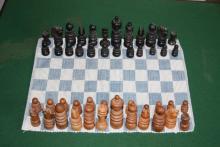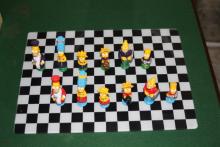Chris Bellers, Exeter Chess Club
This session comes out of a remark by ex-World Champion Tigran Petrosian, to be found in an excellent book, 'Opening Preparation' by Mark Dvoretsky and Artur Yusupov. In the middle of annotations to a game by Henrique Mecking in 1972 the authors quote Petrosian:"Mecking does not understand the significance of weak and strong squares. I have played him three times. In 1969 he lost to me owing to the weakness of his light squares. A year later he presented me with all the dark squares and again suffered defeat. And in the San Antonio tournament of 1972, Grandmaster Mecking again let me have dark-square control, and with it - victory. What distinguishes Mecking is lively piece play, but he has no genuine grasp of the underlying nature of a position; this is what makes me have doubts about his future as a player."So what are weak and strong squares? Generally, a weakness on squares of a particular colour usually results from exchange of a Bishop, and/or placing Pawns on the same colour squares as the Bishop. Here's another lesson Mecking failed to learn about squares.
Polugaevsky Lev - Mecking H [A11], Mar del Plata, 1971
1. c4 c6 2. Nf3 d5 3. e3 Nf6 4. Nc3 e6 5. b3 Nbd7 6. Bb2 Bd6 7. d4 O-O 8. Bd3 Re8 9. Qc2 e5 10. cxd5 cxd5 11. dxe5 Nxe5 12. Nxe5 Bxe5 13. Ne2 Qd6 14. Bxe5 Qxe5 15. O-O Bd7 16. Nd4 Rac8 17. Qe2 Qd6
|
The Queen goes on the opposite coloured squares to the Bishop, covering the Queen's-side squares, and preparing to advance the Pawns there if opportunity allows.
18... a6 ?!
Placing a Pawn on the same colour as his Bishop.
19. Rac1 Ng4 20. Nf3 Qb6 21. Rxc8 Rxc8 22. Rc1 Nf6 23. Rxc8+ Bxc8 24. Qc3 Bd7 25. Nd4 Ne8 26. a4 !
On its way to a5.
26... Qc7
[26... a5 27. Bb5 Bxb5 28. Nxb5 and things are ready to drop.]
27. Qxc7 Nxc7 28. a5 Kf8 29. Kf1 Ke7 30. Ke2 g6 (a further weakness) 31. Kd2 Ne6 32. Nxe6
[32. Kc3]
32... fxe6 33. f4 e5 34. g3 Kd6 35. Kc3 Be6 36. Kb4 exf4
[36... d4]
37. gxf4 Bg4 38. Kc3 Bf3 39. Kd4 Bg2 40. h4 Bf3 41. b4
following the well-known endgame rule, 'do not hurry'.
41... Bh1 42. Be2 Bg2 43. Bg4 Be4 44. Bc8 Kc7 45. Be6 Kd6 46. Bg8 h6 47. Bf7 h5 48. Be8 Bc2 49. Bf7 Be4 50. f5 !
50... Bxf5 51. Bxd5 Bc8 52. e4 Ke7 53. Ke5 g5 54. hxg5 h4 55. g6 h3 56. g7 h2 57. g8=Q h1=Q 58. Qf7+ Kd8 59. Qf8+ 1-0
Another excellent example is contained in 'Think Like a Grandmaster' by Kotov. The game Kotov-Pilnik, Stockholm 1952 was adjourned after 41 moves:
Kotov,A - Pilnik,H (Sweden izt ) (09) [D56] , 1952
1. d4 Nf6 2. c4 e6 3. Nc3 d5 4. Bg5 Be7 5. e3 O-O 6. Nf3 h6 7. Bh4 Ne4 8. Bxe7 Qxe7 9. Qc2 c6 10. Be2 Nd7 11. O-O Nef6 12. Rad1 a6 13. a3 b5 14. cxd5 cxd5 15. a4 b4 16. Na2 Rb8 17. Nc1 b3 18. Nxb3 Qb4 19. Na1 Qxb2 20. Rb1 Qxc2 21. Nxc2 Ne4
|
|
'By my Bishop,' he replied, and I could not make my mind up whether he was serious or joking. Just in case I decided not to spoil his illusions, lest he should suddenly find a way of rearranging his Pawns.
White's advantages are:
1. All of the Black Pawns are on the colour of his Bishop, restricting its mobility so much that in effect it can take no part in the game.
2. All White's pieces are mobile, while Black's are huddled together in the last two ranks.
3. Black has two significant weaknesses at a6 and f7, and by combining attacks on them White should be able to force win of material.
The correct plan is clear: after suitable preparation advance h5 and after gxh5 Bxh5 pile up winning pressure on f7.
42. Be2 Nb8 43. Nd3 Ke7 44. Ne5 Nc6 45. Kb2
planning Nxc6 and Ra1-c1, when the Bishop ending will be lost
45... Rb7+ 46. Kc3 Kd6 47. Nxc6 Rc7 48. Kd2 [Another source gives 48. Kb3] Rxc6 49. Rf1 Rc7 50. h5 gxh5 51. Bxh5
|
51... Rb7(+) 52. Kc3 Rc7+ [53. Kb3 Rb7+ 54. Kc3 Rc7+ this sequence is omitted by one source] 55. Kd2 Rb7
|
56. Rxf7 Rb2+ 57. Ke1 Rg2 58. Rg7 Bd7 59. Bf3 Rh2 60. Rg8 Ke7 61. Rg7+ Kd6 62. Be2 Rh1+ 63. Kf2 Rh2+ 64. Kf3 Be8 65. g6 Rh8 66. Bxa6 e5 67. dxe5+ Kxe5 68. Bb7 Rf8+ 69. Kg3 Kf6 70. Rc7 Bxg6 71. a6 d4 72. exd4 Rg8 73. Kf2 1-0
Weak squares arise where there is as chain of Pawns on the same coloured squares, as the Pawns deprive themselves of control over the other coloured squares, and these squares become accessible to the enemy pieces. These weaknesses can be decisive if there is no Bishop defending these squares either, and is even worse if the only Bishop for that side travels on the same colour squares.
In the following position:
8/3B3P/P2K2P1/1P1P2p1/1p1k1p2/3n4/p5p1/8
|
1. Nc5 Bc8 2. g3 (a tempo move to Zugzwang Black) 2...Bc5 3. Nxa6 Bc8 4. Nc5 Bf5 5. Nd3 Bc8 (the K and P endgame is lost) 6. Nf2 Bf5 7. Nd1 Bd7 8. Nc3 Bc6 9. a3 forces the win of a second Pawn.
An identical position arose in Karpov-Hort except that White had a Bishop, rather than a Knight on d3.
Karpov,Anatoly - Hort,Vlastimil (2), Budapest, 1973
1. e4 e6 2. d4 d5 3. Nd2 Nf6 4. e5 Nfd7 5. c3 c5 6. Bd3 Nc6 7. Ne2 Qb6 8. Nf3 cxd4 9. cxd4 f6 10. exf6 Nxf6
|
|
|
|
40...Bg4 41. Bc2 Be6
[41... Be2 42. f5]
42. Bb3 Bf7 43. Bd1 Be6 (else 44.Bg4) 44. Bf3 Bf7 45. Bg4 1-0
Riumin - Ragozin, Leningrad, 1934
1. d4 Nf6 2. c4 e6 3. Nc3 Bb4 4. Qc2 d5 5. e3 O-O 6. Nf3 Nc6 7. a3 Bxc3+ 8. Qxc3 Bd7 9. b4 a5 10. b5 Na7 11. a4 c6 12. Ba3 Re8 13. Rb1 dxc4 14. b6[14. Bxc4 cxb5 15. axb5 Rc8 16. Qd3 Nd5]
[14. Qxc4 cxb5 15. axb5 Rc8 16. Qb3 Nd5 with light-square control for Black in each case]
14... Nb5! 15. axb5 cxb5 16. Ne5
[16. Bb2]
[16. Bc1]
16... b4 17. Qc1 Bb5 18. Be2 Rc8 19. Bxb4 axb4 20. Rxb4 Ba6...
and Black soon won 0-1
Kotov - Gligoric,Zurich [E87] 1953
1. d4 Nf6 2. c4 g6 3. Nc3 Bg7 4. e4 d6 5. f3 O-O 6. Be3 e5 7. d5 c5 8. Bd3 Nh5 9. Nge2 f5 10. exf5 gxf5 11. Qc2
|
11... e4 Startling! 12. fxe4 f4 (the point) 13. Bf2 Nd7 14. Ng1
[14. e5 Nxe5 15. Bxh7+ Kh8 when Black's pieces are too strong]
14... Qg5 15. Bf1 Ne5
|
16. Nf3 Qe7 17. Nxe5 Qxe5 18. O-O-O Nf6 19. h3 Bd7 20. Bd3 a6 21. Nb1 (hoping to get to f3) 21... f3! 22. gxf3 Nh5 23. Nd2 Nf4 24. Bf1 b5 25. h4 Kh8 26. Rg1 Bf6 27. Nb3 Rab8 28. Be1 b4 29. Kb1 Ra8 30. Bg3 Rg8 31. Qh2 Rxg3! 32. Rxg3 Ne2 33. Qxe2 Qxg3 34. Nc1 a5
[34... Rg8]
[34...Qxh4]
35. Nd3 Bd4 36. h5 Qh4 37. Bg2 Rg8 38. Rh1 Qg3 39. Bf1 a4 40. Kc2 a3 41. b3
|
1/2-1/2
You should be aware of another possibility in some King's Indians, once the f-Pawn have moved, of playing ...Bh6, answering Bxh6 with ...Qh4+ and ...Qxh6 easing Black's game because of the weakened dark squares in the White position.
Returning to the start of this session, what of Petrosian's three games against Mecking? The first game is given in full, not only because it is a masterpiece, but because I leave it for you to work out where Mecking went wrong. The second ended as follows:
|
The third game went into the following endgame:
|
62. Ke2 Kf4 63. h4 g5 64. hxg5 Kxg5 65. Ke3 Ng4+ 66. Kf3 h4 67. Bd1 Nf6 68. Bb3 Kf5 69. Kg2 Kg4 70. Bd1+ Kf4 71. Bb3 Ne4 72. Bc2 Nc3 73. Bb3 Ne4 74. Bc2 Nf6 75. Bb3 Kg4 76. Kh2 Ne4 77. Kg2 h3+ 78. Kg1 Kf3 79. Bd1+ Kf4 80. Bc2 Nf6 81. Bb3 Ng4 82. Ba4 h2+ 83. Kg2 Nxf2 84. Kxh2 Nd3 85. Kg2 Ke3 86. Kg3 Nc1 0-1
Petrosian,Tigran - Mecking,Henrique [B07] Palma
de Mallorca (5 ), 1969
1. d4 g6 2. e4 Bg7 3. Nf3 d6 4. c3 Nf6 5. Nbd2
(Geller's quiet system, aiming at a small plus) 5...
O-O
|
|
+= Nunn, but Petrosian wins without fuss. Where did Black go wrong?
15... Bc6
|
16. Qe2 Ne5 17. Nxe5 Bxe5 18. g3 Bg7 19. Bf4 e5 20. Bc1
(Also typical Petrosian. Having tempted ...e5, the Bishop returns to base.The other effect of this move is that it might make Black do something hasty later.)
20... Kh8
|
(White can draw up a battle plan: (1) fix the Black Pawns, (2) tie Black's pieces to their defence, (3) penetrate on the light squares.)
24... f4 25. axb6 axb6
|
|
31. Rxa8 Rxa8 32. Bd2 Re8 33. Bc3 Qd6
(Phase (2) is complete: the Black pieces are tied to defence.)
34. Re1 h6 35. Ra1 Rf8
|
|
Example games about colour complexes
Petrosian,Tigran - Mecking,Henrique [D03], Wijk aan Zee (6 ), 1971
1. d4 Nf6 2. Nf3 e6 3. Bg5 c5 4. e3 d5 5. c3 Nc6 6. Nbd2 cxd4 7. exd4 Be7 8. Bd3 h6 9. Bf4 Nh5 10. Be3 Nf6 11. Ne5 Nxe5 12. dxe5 Nd7 13. Bd4 Nc5 14. Bc2 a5 15. Qg4 g6 16. O-O Bd7 17. Rfe1 Qc7 18. a4 Na6 19. Qe2 Kf8 20. Nf3 Kg7 21. Be3 Nc5 22. Nd4 Ra6 23. Bc1 Raa8 24. g3 b6 25. h4 h5 26. Qf3 Qd8 27. Bd2 Qe8 28. Bg5 Qd8 29. Qf4 Rc8 30. Re3 Bxg5 31. hxg5
|
Mecking,Henrique - Petrosian,Tigran (10) [C11], San Antonio, 1972
1. e4 e6 2. d4 d5 3. Nc3 Nf6 4. Bg5 dxe4 5. Nxe4 Be7 6. Nxf6+ Bxf6 7. Bxf6 Qxf6 8. c3 O-O 9. Bd3 Nc6 10. Qh5 g6 11. Qf3 Qg7 12. Ne2 e5 13. d5 Ne7 14. O-O f5 15. Bc4 Kh8 16. Rad1 f4 17. Rfe1 Nf5 18. Nc1 Nd6 19. Bf1 e4 20. Qe2 f3 21. gxf3 Rxf3 22. Nb3 Bg4 23. Nd4 Raf8 24. Nxf3 Bxf3 25. Qd2 Qd7 26. h3 Kg8 27. Re3 Bxd1 28. Qxd1 Qf5 29. Re2 Qg5+ 30. Bg2 Rf5 31. c4 Nxc4 32. Rxe4 Nd6 33. Re3 Re5 34. Rxe5 Qxe5 35. Qc1 Qe7 36. Qc3 b6 37. b3 a5 38. Kf1 Qg7 39. Qc1 Qe5 40. Bf3 Nf5 41. Qg5 Kg7 42. Kg2 Qf6 43. Qf4 Qd6 44. Qe4 Kf6 45. Qc4 Qe5
|
|
Nimzowitsch Aaron - Menchik,V (Karlsbad) [C02], 1929
1. e4 e6 2. d4 d5 3. e5 c5 4. Qg4 cxd4 5. Nf3 Nc6 6. Bd3 Qa5+ 7. Nbd2 Nge7[7... Qc7]
8. O-O Ng6 9. Re1 Be7 10. h4 Bf8
|
11. h5 Nge7 12. Nb3 Qc7 13. Nbxd4 Nxd4 14. Nxd4 Bd7 15. Bg5
|
Nudges the dark-squared Bishop into exchange.
21... Bxd4 22. cxd4 Be6 23. Rc5
|
23... Kd7 24. Qf3 Qxb4 25. Rxd5+ Ke8 26. Rc1 Bxd5 27. Qxd5 Qb6 28. Qf3 gxh5 29. Qa3 Qe6 30. Rc7 1-0























































































